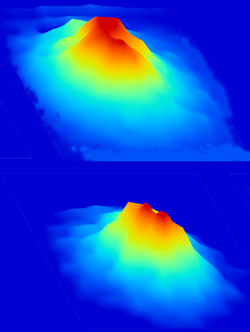The Travels of An Exciton

Researchers have tracked their first exciton. A team reports in the 24 October PRL that they imaged the wave-like motion of the particle, which is essential to the operation of lasers in CD players and grocery scanners. They detected the light of a single trapped exciton and distinguished it from that of a double-particle called a biexciton. The technique may be used in the future to view the wave nature of other nanoscale particles.
When an electron in a semiconductor moves away from its native atom, the vacated spot is known as a hole, and it can act as if it were a positively charged particle. When a negatively charged electron meets a positively charged hole, they attract and can orbit around one another for a brief time before combining and emitting light. During that nanosecond-long dance, the particle pair is called an exciton.
Excitons produce the light in light emitting diodes (LEDs) and in laser diodes found in CD players and laser pointers. They may also play a role in future quantum computer technologies. Like all quantum-scale particles, an exciton does not exist at a single point but is described by a wave–or wave function–that gives the probability of finding it in any given location. A trapped particle at low energy has a wave function with a central peak where it is most likely to be found and a width that gives the distance the particle is likely to roam from the center. This “roaming distance” is related to many basic physical properties, but previous attempts to gauge it have relied on indirect methods. Images of the light from excitons have only captured them as single points.
Kazunari Matsuda of the Kanagawa Academy of Science and Technology and the Japan Science and Technology Agency, and his colleagues, measured the wave function of an exciton by mapping with high resolution the light it gave off when the electron and hole combined. They repeatedly zapped a 100-nanometer-diameter raised patch of semiconductor called a quantum dot with laser light delivered through a microscopic glass fiber. Each light pulse created a single exciton and biexciton on the dot, and the team used the same fiber to collect the light released with each death of the particles. The researchers kept their 20-nanometer-diameter probe tip in the same spot for many cycles before moving to the next position and gradually built up a complete picture. They distinguished the exciton from the biexciton by observing at characteristic wavelengths of light for each type of particle.
The images show that an exciton strays farther from the center of a quantum dot than does a biexciton. The particles act like balls rolling inside a valley, and the heavier particle–the biexciton–can’t roll as far up the sides as the lighter particle can.
Matsuda and colleagues present “a major step forward in nanospectroscopy,” says Christoph Lienau of the Max-Born Institute in Berlin. He adds that because the technique can resolve objects less than 30 nanometers in size, direct optical mapping of other nano-size objects is within reach. Dan Gammon of the Naval Research Laboratory in Washington, DC, agrees but says the technique is still very difficult. Matsuda says his group hopes to further develop imaging techniques at nanoscales and explore how light from a nano-sized source interacts with matter.
–Kim Krieger
Kim Krieger is a freelance science writer in Norwalk, Connecticut.


